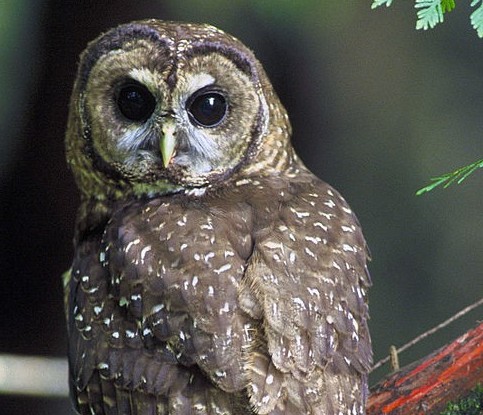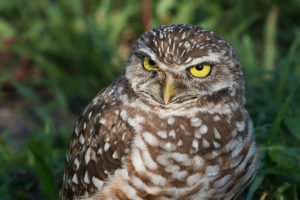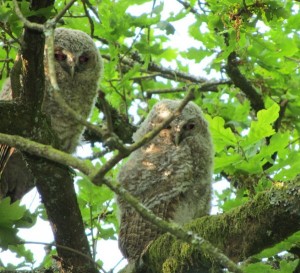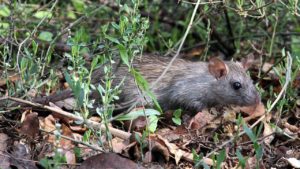Owl Vs. Owl
An in-depth study of the northern spotted owl has examined its decline in the Pacific Northwest of the United States. Removal of the invasive barred owl may be one solution, in combination with long-term protection of its habitat.

Scientists are puzzling out how to address the declining numbers of northern spotted owls (NSO) in their Pacific Northwest forest habitat. A new study in the Ecological Society of America’s journal Ecological Applications explores the reasons why spotted owls are losing a foothold in their habitat, forecasts future habitat conditions and species interactions, and suggests best management practices.
The U.S Fish and Wildlife Service first listed the species as “threatened” under the Endangered Species Act in the late 20th century because years of over-logging left the owls’ forest home degraded. The U.S Forest Service and the Bureau of Land Management began actively managing federal lands using the 1994 Northwest Forest Plan that focuses on preserving and increasing the acreage of the spotted owls’ preferred mature forests habitat.
The NSO had been at the centre of controversy in the 1990s, pitting loggers and sawmill owners against environmentalists. The logging industry believed that protection of the owl would lead to a loss of up to 30,000 of 168,000 jobs because of the owl’s protected status, and that it was a case of environmental protection going too far. However, logging jobs had been long in decline due to dwindling old-growth forest harvests and automation of the lumber industry. And environmentalists believed that NSOs are “canaries in the coal mine” and that their protection has protected the entire threatened ecosystem. The debate led to the production of bumper stickers that read “kill a spotted owl…save a logger” and plastic owl effigies were hung in sawmills in Oregon.
The 1994 plan resulted in much less logging, and because of the decline due to automation, thousands of logging jobs were lost. Yet many were created for biologists conducting surveys for spotted owls and other species in the area.
As for the owls, some restoration of the forest is occurring, but there are other pressures affecting the forests such as the 2002 Biscuit Fire that burned nearly 500,000 acres in southern Oregon and northern California. From the beginning of the implementation of the 1994 plan, managers expected owl populations to continue declining because regrowth and recovery of old forest is a slow process that occurs over decades.
And yet, even with those projections, mangers and ecologists are surprised NSO populations are decreasing at a greater rate than anticipated. The reason? The northern spotted owls are not alone in their forests.
Barred owls began to invade the northern portion of spotted owl’s range about 50 years ago. They are native to eastern North America but are considered to be invasive on the west coast of Canada and the United States, where they have been spreading to since the 1960s. Although they existed in low numbers in 1994 when the Northwest Forest Plan went into effect, unfortunately barred owls quickly increase in numbers.
“We have known for some time that NSO are reliant on older forest as habitat, that recovering NSO would require recovering this habitat, and that this process of recovery would take many decades,” says lead author Charles Yackulic of the U.S. Geological Survey. “Twenty-five years ago, however, we did not anticipate the increases in barred owl abundances would lead to a second major threat to NSO recovery.”
The invading barred owl competes with the spotted owl for prime nesting spots and hunting areas. The barred owl is winning the fight and may push the spotted owl to localised extinction in the region in the next few decades without managers intervening. The barred owl is changing the entire ecosystem, so other animals in the forest are losing along with the spotted owl.
Yackulic continues: “NSO are only found in the Pacific Northwest and play a unique role in the food webs of intact forest in this region. While barred owls serve some similar ecological functions, they eat a broader range of prey and there is evidence their invasion is leading to trophic cascades – unexpected declines in other members of the ecological communities because of differences in how NSO versus barred owls interact with food webs.”
In the paper, the researchers analyse the relative importance of habitat conditions and barred owl competition in past and future NSO territorial population dynamics in eleven study areas. They also forecast the future interactions between the two owl species under current management conditions and under scenarios with various levels of barred owl removal or changes in habitat.
They find that recent wide-range declines in NSO occupancy are driven primarily by competition with increasing barred owl populations and removal of barred owls is an effective management option to prevent declines in the near future. Although there are worries that this would shift the blame completely to barred owls and less attention will be paid to habitat protection…and potentially the resumption of logging.
Plus, barred owl removal is not enough on its own. While barred owl removal could stabilise NSO populations in the short-term, forest regeneration can take 50 or more years. Maintaining or improving habitat conditions is an important factor in promoting spotted owl survival over longer periods and allows managers to be less reliant on barred owl removals in the future.
In short, spotted owl populations survival may depend on managers’ using a two-fold approach of removing barred owls in the short term and preserving the forests in the long term. The researchers project this combination results in a 95% probability that spotted owls will persist in these areas for 50 or more years, a best-case scenario. However, without either practice, should habitat conditions worsen and barred owls are not removed at all, spotted owls will be extinct from many of the study areas within decades.
In the future, the researchers hope to understand how to effectively use barred owl removal methods, and where to prioritise them. They also want to identify if any habitat conditions can support both owl species. Who knows – there may be situations under which NSO can coexist with barred owls, and the two can manage to get along.





No comments yet.